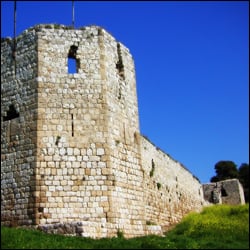Background
It was in the waning days of King Solomon’s reign when G‑d sent the prophet, Achiyah of Shiloh, to rebuke Solomon and inform him that, due to his sins, G‑d would tear the kingdom away from him, but that, in the merit of King David his father, G‑d would tear it away only from King Solomon’s son, leaving him to rule over one tribe.1
Shortly thereafter, in the year 29642 from creation, King Solomon passed away, and the people of Israel gathered in the city of Shechem for the coronation of his son, Rehoboam. Having been burdened with heavy taxes during King Solomon’s reign, the people wished to know what Rehoboam’s policies would be. Taking the bad advice of his younger advisers, Rehoboam confronted the people with the statement:
My father made your yoke heavy, and I will add to your yoke; my father chastised you with whips, but I will chastise you with scorpion-thorns.3
Hearing this, the people of Israel dispersed and set up their own kingdom in the northern part of Israel, with Jeroboam the son of Nevat as their king.
Jeroboam feared that if the Jews were allowed to go and bring offerings in the Holy Temple in Jerusalem, their hearts might revert to being faithful to the king of Judea, and he, Jeroboam, would eventually be assassinated. He therefore set up idols at the two ends of his kingdom, one in Bethel and one in Dan, saying, “It is far for you to go up to Jerusalem; here are your gods, O Israel, who have brought you up from the land of Egypt.”4 Additionally, Jeroboam placed sentries and roadblocks on the roads leading to Jerusalem, in order to stop anyone attempting to go up to the Holy Temple. The roads leading to Jerusalem would remain blocked until they were removed by Hoshea, the last king of the northern kingdom.
Only the tribes of Judah and Benjamin5 still recognized the dynasty of King David and his grandson, Rehoboam, under the kingdom of Judea.
The Northern Kingdom’s Demise
The people of the northern kingdom would continue in the sinful and idolatrous ways of their forbears throughout the generations. However, it was during the reign of King Jeroboam the son of Joash (Jeroboam II),6 the thirteenth king of the Northern Kingdom, that the Jews there reached new lows in their evil ways.
King Jeroboam II subdued the neighboring kingdom of Moab, captured parts of Syria, and made peace with the kingdom of Judea. The stable political situation resulted in economic prosperity. They cultivated friendly relations with the Phoenicians, who were the greatest merchants and seafarers of those days, and brought items of rare beauty and luxury into the Jewish kingdom. Unfortunately, the unusual prosperity brought a collapse of moral standards. The Jewish ideals (and commandments) of helping the poor and practicing justice and lovingkindness were ignored. It was an age of corruption. Hand in hand with this degeneration of morals was an increase in idolatry. People built many altars on mountains to serve the Canaanite gods, Baal and Astarte. The golden calves, idols which Jeroboam I had set up in the north and south of the country to turn the people away from the Holy Temple in Jerusalem, were worshipped more than before, and the teachings of Judaism and the holy commandments were viewed with contempt.
G‑d sent the prophet Amos to admonish the Jews and warn them of their impending exile and the destruction of the house of Jeroboam7 if they did not repent and return to G‑d.8 Instead of heeding his warning, they became angry, and their leader, the false priest Amaziah, incited the people to harm Amos.
However, King Jeroboam, in an act of rare respect for the word of G‑d and his prophets, protected the prophet, and did not let harm befall him. It was in the merit of the respect showed to Amos that his reign lasted for 41 years, by far the longest reign of the Northern kings.9
After King Jeroboam II’s demise, the Northern Kingdom started to decline rapidly. A mere six months after his father’s death and his own coronation, King Zechariah was assassinated by Shallum the son of Jabesh.10 After this, almost all of the kings ruled and came to power through the sword. It is for this reason that the subsequent rulers are sometimes referred to as “usurpers” rather than kings.11
The Ten Tribes
In the year 3154, one hundred and ninety years after the two kingdoms had split, Menahem ben Gadi seized the throne by assassinating Shallum—who had ruled for a mere month—and became the sixteenth king of Israel. It was during his reign that the Assyrians invaded the land of Israel.12 King Menahem, a brutal monarch who at the slightest hint of rebellion would destroy entire cities, had to contend both with his rapidly decreasing popularity and with the Assyrian invasion. As such, rather than resist the invaders, he preferred to levy a heavy tax on his subjects in order to pay tribute to the Assyrians in exchange for a promise to support his rule.13
The weight of Assyria’s dominion over the land of Israel began to bear down more heavily. King Pekah seized the throne after assassinating King Pekahiah, Menahem’s son. Seeing that there was no escape from complete subjugation by Assyria, he joined the revolt which King Rezin of Syria had organized against Assyria, in the hope of enlisting Egypt in an effort to stem the tide of the Assyrian conquest.
After King Jotham (and later his son King Ahaz) of Judea refused to join the revolt against the Assyrians, Pekah and Rezin invaded Judea, killing scores of its inhabitants. King Achaz then appealed to King Tiglath-Pileser of Assyria to come to his rescue. King Tiglath-Pileser jumped at the opportunity and marched into Syria, defeated King Rezin and annexed his land, making it one of Assyria’s provinces. He then turned against Israel and annexed part of the land, taking the tribes of Naphtali14 and Zebulun15 captive. Thus it was, in the year 3187, that the first of the ten tribes of the northern kingdom were exiled.16
That very same year, the Assyrian king organized a revolt against King Pekah under the leadership of Hoshea son of Elah, who assassinated the king and was then appointed as a vassal of Assyria.
It was in the year 3195, the eighth year of Hoshea’s service as a vassal to Assyria, that the Assyrians captured the Reubenites, the Gadites, and half the tribe of Manasseh,17 and exiled them to Halah, Habor, Hara, and the Gozan River.18 taking with them the idol that King Jeroboam had set up in Bethel to replace the Holy Temple.19
Seeing this, Hoshea rebelled against the Assyrians and sent messengers to the king of Egypt for support. He then appointed himself as an independent king over the remnants of the northern kingdom.20 Additionally, he removed the blockade which had stood for hundreds of years on the road to Jerusalem, finally giving the Israelites the choice of either serving G‑d in the Holy Temple or continuing to practice idolatry.21 This is the meaning of what the verse describes with regards to Hoshea: “And he did what was evil in the eyes of the L‑rd, though not like the kings of Israel who had preceded him.”22 Nevertheless, although the sentries were removed, the Jews continued in their idolatrous ways and did not go up to the Holy Temple in Jerusalem.23 When Shalmaneser, who had succeeded Tiglath-Pileser as king of Assyria, heard of Hoshea’s rebellion, he ravaged what was left of the land of Israel and laid siege to the capital city of Samaria. After three years, the city finally fell, and they razed the city to the ground, not even leaving any of its foundations standing.24 They then took all of its inhabitants, including the remaining inhabitants of the northern kingdom and their king, as captives.25
Thus it was in the year 3205, at the end of the reign of King Hoshea, the nineteenth king of the northern tribes—coinciding with the sixth year of the reign of King Hezekiah of Judea—that the northern kingdom fell and the rest of the ten tribes were exiled.
This article is one of the three-part series on the lost tribes of Israel. Please have a look at Are the Ten Lost Tribes Ever Coming Back? and Where Are the Ten Lost Tribes?






Join the Discussion